|
International Perspectives - October 4, 1999
Anne D. Picker
International Economist, Econoday
Central banks may act…
This week…
The markets continue to be nervous about interest rates and tensions will rise as they wait for the central banks to act. Possible rate increases are on the agendas in Britain, the European Monetary Union and the United States. The Federal Reserve's Open Market Committee (Fed) will announce its interest rate decision on Tuesday while the European Central Bank (ECB) and the Bank of England's Monetary Policy Committee (MPC) will announce their decisions on Thursday.
The Bank of England's Monetary Policy Committee meets on Wednesday and Thursday amid growing market expectations that it will follow last month's surprise 25 basis point increase to 5.25 percent with a second hike. The markets had expected that the MPC would refrain from raising rates because of the pound sterling's strength. But the pound slipped slightly last week while evidence of the recovery's gathering strength accumulated.
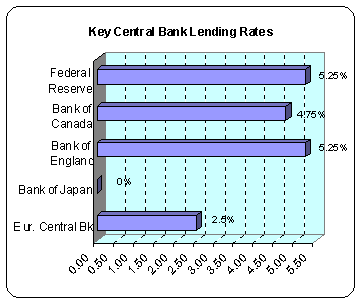
Until recently, the markets had expected that the Fed and the ECB would not lift rates for the rest of this year. But with growth improving in the European Union (EU), market players are no longer sure. Now speculation has reached a fever pitch as the euro continues to rise with every central banker's comment and each data release confirms that the European economies are growing.
Gold (continued)…
The price of gold shot up last week after the European nations agreed to put a moratorium on further sales other than those already planned by Britain and Switzerland. The International Monetary Fund will revalue its gold reserves through a complicated sales and buy back arrangement rather than sell them on the open market.
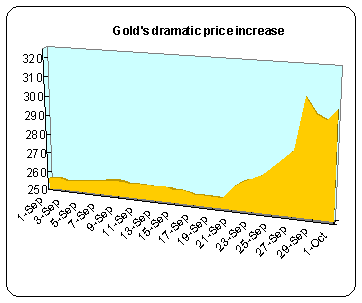
Gold prices soared to $315 a troy ounce before settling down and closing the week at about $305. This is an appreciation of about 20 percent since September 20th - the day before the most recent British gold sale. The gold price climbed immediately after the sale primarily because it was eight times oversubscribed. The price vaulted up after the announcement at the IMF meetings last week that placed a moratorium on the sale of gold by European countries. The announced sales by Britain and Switzerland will go on as already scheduled.
Indicators…
Monthly surveys show continued upward growth trends in Europe…
Several purchasing managers' indices were released on Friday and all indicate accelerating growth during September. An index reading above 50 indicates the manufacturing sector is expanding, while a reading below 50 indicates contraction.
In Germany, the index rose slightly indicating that the manufacturing sector's growth accelerated during the month. The seasonally adjusted index rose to 53.7 from 52.9 in August. Input prices accelerated reflecting suppliers' ability to increase prices due to shortages of certain goods. The output subindex rose to 56.5 from 55.9, indicating output rose at a faster pace to match an increase in orders. New orders continued to rise, although export orders fell slightly.
In Italy, the manufacturing sector expanded for the third month in a row with the index rising strongly to 53.62 from an upwardly revised 51.89 in August. Strong gains in output; new orders and employment were the main factors behind the jump. But prices rose for the third month in a row and at a faster pace than in August.
In France, manufacturing expanded for the eighth straight month. Significantly, the seasonally adjusted price index posted a new high of 69.1. International demand for manufactured goods in a phase of depleted inventories is boosting production. The new orders index rebounded to a new high while new export orders index fell back, but remained over 50 for the ninth month in a row. The employment index also rose.
In the 11 member eurozone, manufacturing activity expanded for the sixth month in a row. The PMI was at its highest level since September 1998. The index, based on data from Germany, France, Italy, Spain and Ireland, rose slightly to 54.7 in September from 53.2 in August. The output subindex rose to 56.5 from 55.1 in August, while the new orders index rose to 56.7 from 54.9 in August. The price index, which is not part of the overall PMI, rose strongly. Employment growth expanded in September, with the index up to 52.3 from 51.2 in August.
In Britain, manufacturing activity grew at its fastest rate in 22 months, according to a seasonally adjusted index from the Chartered Institute of Purchasing and Supply. In September, the CIPS purchasing managers' index rose to 53.9 - the highest level since November 1997 - compared with 53.1 in August. All main indicators highlighted the acceleration in activity. Average input prices rose strongly for a second month running. Producers of intermediate and consumer goods were especially affected by price increases, which were attributed primarily to strong global demand for many commodities. Total new orders picked up for the sixth month in a row while export orders grew strongly as well, rising for the fifth consecutive month.
Other indicators show a positive trend…
Italy
August preliminary producer prices were up 0.3 percent on the month and unchanged when compared with last year. The increase reflected higher oil and chemical prices in addition to increases in meat and cheese prices.
The non-EU trade surplus narrowed in August. Imports rose sharply but exports fell, although at a slower rate than in recent months. Exports to non-EU countries remained below year ago levels, but the decline in exports continues to slow as imports surge. Non-EU imports were up 20.4 percent when compared with last year, the largest increase since February 1998. The import gain could be linked to rising imported raw materials costs such as oil for use in production.
United Kingdom
Consumer credit growth in the UK slowed slightly in August, showing a smaller than expected increase. It grew by 1.1 percent on the month and 14.1 percent on the year. Net credit card lending was still quite strong, but was down from July.
France
Seasonally adjusted unemployment rose by 1.2 percent in August, according to the International Labor Organization (ILO) definition, which excludes job seekers that did any work during the month. This pushed the unemployment rate back up to 11.3 percent after it dipped to 11.2 percent in July. The unemployment level was still down 4.1 percent from August 1998, when the ILO rate stood at 11.9 percent.
Spain
The jump in non-seasonally adjusted August producer prices was due largely to higher energy prices. Non-seasonally adjusted Spanish producer prices rose 0.6 percent - the same as in July. The stronger than expected increase pushed the annual producer inflation rate up 1.4 percent - double the 0.7 percent posted in July.
EMU
The 11 nations of European Monetary Union posted a trade surplus with the rest of the world of 12.1 billion euros during July, down from a surplus 13.6 billion euros when compared with a year earlier. Exports were up one percent when compared with July 1998 after a three percent year on year increase in June. Imports were up three percent when compared with last year.
Asia
Japan
August housing starts rose more than expected and reflected the success of government loan and tax incentives to spark housing investment. Total housing starts rose 8.4 percent from a year ago. It followed a 1.9 percent rise in July and 7.3 percent in June, and a 0.9 percent decline in May.
Total August construction orders received by Japan's 50 leading domestic contractors fell 6.9 percent when compared with the year earlier. August's fall marked the fifth straight month of year on year declines.
Industrial output climbed 4.6 percent in August, the biggest monthly increase in more than two years. It was led by auto makers amid strong demand for new models. The rise in production is the latest of a series of indicators to show that Japan's recovery from its recession last year is taking hold. However, expectations are that manufacturers' production will slow this month because of concerns that a stronger yen will crimp export sales.
The number of August unemployed rose 7.7 percent but the unemployment rate fell slightly to 4.7 percent. There were 3.2 million unemployed in Japan, up 230,000 from the previous year. The labor force participation rate was 63.3 percent, down 0.4 percent from the previous year. Japan's unemployment rate edged lower to 4.7 percent in August from July's 4.9 percent as more men found new jobs.
The consumer price index fell 0.1 percent when compared to last year but rose 0.3 percent in August. The biggest increases were in food prices, which were up 1.3 percent on the month and 1.6 percent on the previous year.
Americas
Canada
Real gross domestic product at factor cost rose 0.4 percent in July with both the goods and service producing sectors participating in the gain. The July increase marked the twelfth consecutive monthly gain, the longest uninterrupted series of gains in more than ten years. On a year over year basis, GDP at factor cost rose 4.6 percent when compared with July 1998. The manufacturing sector was up for the fourth time in five months, and posted the second largest gain after the 1.1 percent gain in June. Overall, 16 of 22 major industry groups accounting for 76.5 percent of manufacturing production were up. Output in the service sector increased 0.3 percent in July after a 0.1 percent gain the previous month and was up 3.9 percent when compared to July of a year ago. Business services and retail trade led gains, both up 0.9 percent in July followed by a gain of 0.8 percent in wholesale trade.
Financial Markets
World Equity Markets
The markets were highly volatile last week as traders interpreted the decisions taken by the Group of Seven at their meeting on September 25th. Subsequent comments by central bankers and monetary officials at the International Fund and World Bank meetings during the last week were filtered by the markets also. Add to this the stronger than expected growth evident in many countries' statistical releases combined with the general market malaise because of upcoming central bank meetings this week, and mood swings were wide.
| Selected World Stock Market Indexes |
| Index | 4-Oct | 1999
High | 1999
Low | Week %
Change |
|---|
| Asia |
| Australia | All Ordinaries | 2912.90 | 3145.20 | 2804.80 | 0.67 |
| Japan | Nikkei 225 | 17712.56 | 18357.90 | 13232.70 | 4.98 |
| Hong Kong | Hang Seng | 12733.34 | 14506.74 | 9076.33 | -2.29 |
| S. Korea | Korea Composite | 938.35 | 1027.93 | 498.42 | -0.34 |
| Europe |
| Britain | FTSE 100 | 5970.70 | 6420.60 | 5770.20 | 0.56 |
| France | CAC |
4550.57 | 4745.48 | 3958.70 | 0.21 |
| Germany | XETRA DAX | 5124.55 | 5652.00 | 4668.50 | -1.20 |
| North America |
| United States | Dow | 10273.00 | 11209.80 | 9120.70 | -0.06 |
| Canada | TSE Composite 300 | 6931.30 | 7292.70 | 6180.30 | 2.48 |
| Mexico | Bolsa |
4985.21 | 7292.70 | 6180.30 | 0.09 |
Europe
The three major stock indices were very volatile last week as interest rate concerns became their primary focus prior to the monetary policy meetings scheduled this week. As mentioned above, the U.S. Federal Reserve, Bank of England and the European Central Bank all have scheduled policy making meetings for this week. The German DAX index closed lower on the week, while the London FTSE and Paris CAC barely closed higher. The intra-week volatility in all three indices is evident on the graph below.
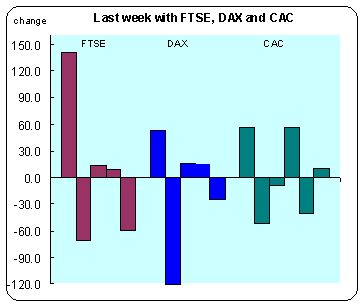
Asia
Asian markets were buffeted by man made and natural disasters last week. The Bank of Japan, while it had agreed to the Group of Seven communiqué on September 25th, continued to exert its independence despite international pressures. By Friday, it was clear that the Bank of Japan would take no action and the yen began to increase in value again after declining for most of the week. The Nikkei closed up about five percent on the week. Other Asian markets were mixed on the week as concerns about the nuclear accident in Japan along with the continued fallout from the earthquake in Taiwan troubled the markets.
Currencies
Euro
The euro strengthened last week as the prospect of higher interest rates combined with favorable growth signs helped push the currency to an eight week high. The hawkish comments by Otmar Issing, ECB chief economist, added to the euro's momentum when he warned that inflation risks were now on the upside. This contributed to market unease in the run-up to the ECB meeting on Thursday. Last Friday's purchasing manager's indexes showed that the manufacturing sector is growing at its fastest pace in over a year.
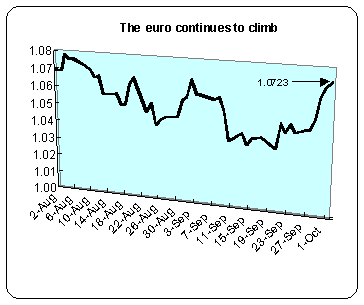
Yen
The yen slid in value after the Group of Seven meeting on September 25th, but resumed its appreciation when it became evident that the Bank of Japan remained content not to intervene at this time. The markets also were anticipating the release of the Bank's Tankan survey of business conditions on Monday, which is expected to show that the economy is continuing its recovery.
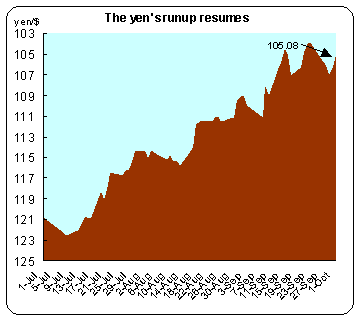
However, the appreciation in the yen (that is, fewer yen per U.S. dollar) means that exports to the United States and elsewhere are becoming more expensive and could slow Japan's recovery. An additional factor that may have weighed on the markets was the third quarter close on Thursday and the accompanying need to square positions.
Why U.S. investors care…
The evidence of stronger world growth is good news to U.S. investors because it provides more investment opportunities in order to construct a more balanced portfolio. The down side is increasing demand for inputs and commodities could add to inflationary pressures within the U.S. economy because prices will be bid up for scarce resources. Should the dollar continue its downward slide in value against the yen and euro, this too would add to inflationary pressures by making imports more expensive. However, higher import prices could help tame the U.S. burgeoning trade deficit by reducing imports. Stronger world growth combined with the cheaper dollar will increase exports to Europe and Asia. This too would have a beneficial affect on the trade deficit.
Looking Ahead
|
Central Bank Policy Committee Meetings… |
| Oct 5 | US | Federal Reserve Open Market Committee |
| Oct 6 | UK | Bank of England Monetary Policy |
| | Committee Meeting begins |
| Oct 7 | UK | Bank of England Monetary Policy |
| | Committee Meeting concludes |
| EMU | European Central Bank meeting and press conference |
|
The following indicators will be released this week. |
| Europe | | |
| Oct 4 | Germany | Wholesale Sales (August) |
| France | Producer Price Index (July/August) |
| UK | CBI Financial Services Survey (3Q, 1999) |
| Oct 5 | Italy | ISAE Business Sentiment Index (August) |
| France | Consumer Sentiment (September) |
| Oct 6 | Germany | New Orders (August) |
| UK | Industrial Production (August) |
| | CBI Distributive Trades Survey (September) |
| Oct 7 | France | Gross Domestic Product (2Q, 1999) |
| UK | Gross Domestic Product (2Q, 1999) |
| EMU | Unemployment (August) |
| | Business and Consumer Survey (August/September) |
| Oct 8 | Spain | Industrial Production (July) |
| Asia | | |
| Oct 4 | Japan | Tankan Survey (3Q, 1999) |
| Oct 8 | Japan | Wholesale Prices (September) |
| | Import/Export Prices (September) |
North America | | |
| Oct 8 | Canada | Employment Situation (September) |
| | Housing Starts (September) |
| Mexico | Trade Balance (August) |
Release dates are subject to change.
For U.S. data releases, see this week's Simply Economics.
|






